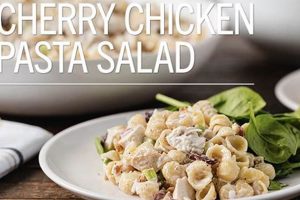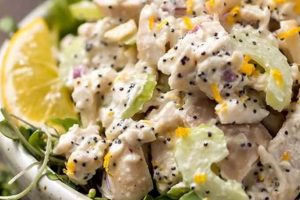A flavorful and convenient dish, this type of salad typically combines crispy fried or shredded cooked chicken with crunchy ramen noodles, vegetables, and a vibrant dressing. Variations can include ingredients such as cabbage, carrots, edamame, green onions, and sesame seeds, while dressings often incorporate soy sauce, vinegar, sesame oil, and ginger. An example might feature shredded rotisserie chicken tossed with broken ramen noodles (seasoning packet discarded), sliced almonds, shredded carrots, and a dressing of rice vinegar, soy sauce, and sesame oil.
This salad offers a balance of textures and flavors, appealing to a wide range of palates. The crispy noodles and tender chicken provide contrasting textures, while the vegetables contribute freshness and nutrients. Its adaptability makes it suitable for various occasions, from potlucks and picnics to quick weeknight meals. The affordability and accessibility of the ingredients further enhance its appeal. Historically, the dish likely emerged as a creative way to utilize readily available ingredients, gaining popularity as a budget-friendly yet satisfying option.
Further exploration of this culinary concept will delve into specific ingredient combinations, dressing variations, preparation methods, and nutritional information to provide a comprehensive understanding of its versatility and appeal.
Tips for Preparing a Superior Ramen Noodle Salad
Optimizing ingredient selection and preparation techniques elevates this simple salad to a culinary delight. Attention to detail ensures a balance of flavors and textures for an enjoyable dining experience.
Tip 1: Noodle Preparation: While convenient, discard the flavor packet included with the ramen. Its high sodium content can overpower the other ingredients. Instead, toast the noodles briefly in a dry pan or bake them for added crispness.
Tip 2: Chicken Selection: Pre-cooked options like rotisserie or leftover grilled chicken streamline preparation. Alternatively, poaching or pan-frying chicken breasts offers greater control over seasoning and texture. Shredding or cubing the chicken ensures even distribution throughout the salad.
Tip 3: Vegetable Variety: Embrace seasonal vegetables for optimal freshness and flavor. Consider shredded carrots, chopped bell peppers, snap peas, or edamame for added color, texture, and nutritional value.
Tip 4: Dressing Customization: A well-balanced dressing enhances the salad’s flavor profile. Experiment with different combinations of soy sauce, rice vinegar, sesame oil, ginger, and a touch of honey or maple syrup for sweetness.
Tip 5: Ingredient Proportion: Strive for a harmonious balance of noodles, protein, and vegetables. Avoid an overabundance of any single ingredient, ensuring each component contributes to the overall flavor and texture.
Tip 6: Advance Preparation: Prepare components such as the dressing and chopped vegetables ahead of time for efficient assembly. However, combine the noodles and dressing just before serving to maintain their crisp texture.
Tip 7: Garnish Enhancement: Toasted sesame seeds, chopped cilantro, sliced green onions, or a sprinkle of crushed peanuts can elevate the salad’s visual appeal and flavor complexity.
By implementing these tips, one can create a flavorful and texturally satisfying salad. Attention to detail ensures a harmonious balance of ingredients, resulting in a dish that is both enjoyable and visually appealing.
These considerations provide a foundation for creating a truly exceptional ramen noodle salad experience.
1. Chicken (cooked, shredded)
Cooked, shredded chicken forms a foundational element in many ramen salad recipes. Its inclusion provides a substantial protein source, contributing to the dish’s nutritional value and satiety. The shredded format ensures even distribution throughout the salad, allowing each bite to contain a balance of flavors and textures. The cooking method influences the final flavor profile; roasted chicken imparts a richer, more savory taste, while poached chicken offers a milder, cleaner flavor. Recipes often call for pre-cooked chicken (such as rotisserie) for convenience, though preparing chicken specifically for the salad allows for greater control over seasoning and texture. This adaptability makes it a versatile ingredient suitable for various flavor combinations.
Consider a classic chicken ramen salad: the tender, shredded chicken provides a textural contrast to the crispy noodles and crunchy vegetables. The neutral flavor of the chicken acts as a canvas, absorbing the vibrant notes of the dressing and complementing the other ingredients without overpowering them. Alternatively, in a spicier rendition, the chicken might be marinated or seasoned with chili flakes before cooking, adding another layer of complexity to the final dish. These examples demonstrate the importance of cooked, shredded chicken as a versatile base upon which diverse flavor profiles can be built.
Understanding the role of cooked, shredded chicken in ramen salad recipes allows for informed ingredient selection and preparation. Choosing the appropriate cooking method and seasoning enhances the overall dining experience, creating a well-balanced and flavorful dish. Considerations regarding pre-cooked versus freshly prepared chicken impact both the convenience and flavor profile. This knowledge empowers individuals to adapt recipes to their preferences, optimizing the balance of taste, texture, and nutritional value.
2. Ramen noodles (crispy)
Crispy ramen noodles constitute a defining characteristic of this salad, contributing significantly to its textural appeal and overall flavor profile. Their preparation and incorporation distinguish the salad from other pasta or noodle-based dishes, offering a unique culinary experience. Understanding the nuances of preparing and utilizing these noodles is crucial for achieving the desired outcome.
- Texture Enhancement
The crispy texture of the noodles provides a satisfying contrast to the softer elements of the salad, such as the chicken and vegetables. This contrast elevates the sensory experience, making the salad more engaging and enjoyable. Consider a salad with soggy noodles; it lacks the dynamic interplay of textures that defines a successful ramen salad. The crispness also offers auditory satisfaction, adding another dimension to the dining experience.
- Flavor Absorption
The porous nature of fried or toasted ramen noodles allows them to absorb the flavors of the dressing more effectively. This ensures that the noodles are not merely a textural element but also contribute to the overall flavor profile. The increased surface area of the broken noodles maximizes their interaction with the dressing, resulting in a more flavorful and cohesive dish. This characteristic distinguishes them from denser noodles that might not absorb flavors as readily.
- Preparation Methods
Various methods exist for achieving the desired crispness, including deep-frying, pan-frying, baking, or even microwaving. Each method yields slightly different results, impacting the final texture and flavor. Deep-frying produces a lighter, airier crispness, while pan-frying can result in a slightly chewier texture. Baking offers a convenient and healthier alternative. Understanding these nuances allows for customization based on individual preferences and available resources.
- Shelf Life and Storage
Maintaining the crispness of the noodles is crucial for preserving the salad’s quality. Proper storage in an airtight container, separate from the other ingredients, helps prevent them from becoming soggy. The noodles can be prepared ahead of time and stored separately, then combined with the remaining ingredients just before serving. This ensures optimal texture and prevents the salad from becoming watery or losing its desirable crispness.
The interplay of these factorstexture, flavor absorption, preparation methods, and storage considerationsdemonstrates the integral role crispy ramen noodles play in defining the character of this salad. Attention to these details elevates the dish from a simple combination of ingredients to a carefully crafted culinary experience. The distinct textural element introduced by the crispy noodles significantly contributes to the overall enjoyment and satisfaction derived from consuming a well-prepared ramen salad.
3. Vegetables (fresh, varied)
Fresh, varied vegetables play a crucial role in chicken ramen salad recipes, contributing significantly to nutritional value, textural complexity, and overall flavor balance. Their presence elevates the dish beyond a simple combination of ingredients, transforming it into a more complete and satisfying meal. The strategic selection and incorporation of diverse vegetables enhance both the culinary and nutritional aspects of the salad.
The inclusion of fresh vegetables introduces a variety of vitamins, minerals, and fiber, enriching the nutritional profile. For instance, shredded carrots provide beta-carotene, while chopped bell peppers contribute vitamin C. This nutritional diversity complements the protein from the chicken and carbohydrates from the noodles, creating a more balanced meal. Furthermore, the textural contrast between crisp vegetables and other components adds a dynamic element. Consider the crunch of shredded cabbage against the tender chicken and crispy noodles; this interplay of textures elevates the sensory experience. Moreover, varying the types of vegetables introduces a broader spectrum of flavors. The subtle sweetness of shredded carrots, the peppery bite of radishes, and the refreshing coolness of cucumbers create a more complex and nuanced flavor profile.
Practical applications of this understanding include adapting recipes to seasonal availability. Utilizing in-season vegetables maximizes freshness and flavor while potentially reducing costs. Furthermore, tailoring vegetable choices to individual dietary needs or preferences allows for customization. Someone seeking a lower-carbohydrate option might emphasize leafy greens and cruciferous vegetables, while another individual might prioritize vibrant colors and diverse textures. Challenges might arise in balancing the desired variety with maintaining textural integrity; certain vegetables might become soggy if prepared too far in advance. Careful planning and appropriate storage techniques mitigate this challenge, ensuring a successful outcome. Ultimately, the thoughtful inclusion of fresh, varied vegetables enhances the nutritional value, textural complexity, and flavor profile of chicken ramen salad recipes, transforming a simple dish into a more satisfying and healthful culinary experience.
4. Dressing (flavorful, balanced)
The dressing serves as a unifying element in chicken ramen salad recipes, binding the diverse ingredients and significantly influencing the overall flavor profile. A well-crafted dressing elevates the dish beyond a simple combination of components, transforming it into a cohesive and harmonious culinary experience. The balance of flavors within the dressing is paramount; it should complement the other ingredients without overpowering them, creating a synergistic blend of tastes and textures. A flavorful, balanced dressing considers the inherent qualities of the other componentsthe savory chicken, the crispy noodles, and the fresh vegetablesand enhances their individual characteristics while creating a unified whole.
Cause and effect relationships exist between the dressing’s composition and the final outcome. For instance, a dressing overly reliant on soy sauce can result in an excessively salty salad, masking the subtle flavors of the other ingredients. Conversely, a dressing lacking acidity might not provide sufficient brightness to cut through the richness of the chicken and the potential fattiness of the fried noodles. Real-life examples illustrate this principle. A sesame-ginger dressing, with its balanced blend of savory, sweet, and tangy notes, complements the nutty flavor of sesame seeds often included in the salad while providing a refreshing counterpoint to the crispy noodles. Alternatively, a peanut-based dressing adds richness and depth, harmonizing with the savory chicken and providing a cohesive flavor profile. These examples demonstrate the practical significance of understanding the interplay of flavors within the dressing.
Practical applications of this understanding involve adapting dressing recipes to individual preferences and dietary needs. Adjusting the proportions of ingredients like soy sauce, vinegar, and oil allows for customization of the final flavor profile. Furthermore, incorporating ingredients like fresh herbs, spices, or citrus zest can add complexity and depth to the dressing. Challenges might arise in achieving the desired balance; careful tasting and adjustment are essential throughout the preparation process. Ultimately, a flavorful, balanced dressing acts as the cornerstone of a successful chicken ramen salad recipe, transforming individual components into a unified and delightful culinary creation.
5. Preparation (efficient, timely)
Efficient, timely preparation is crucial for maximizing the quality and enjoyment of chicken ramen salad recipes. This aspect impacts not only the final flavor and texture but also the overall convenience and practicality of preparing the dish. Strategic planning and execution streamline the process, ensuring a successful outcome without unnecessary complexity or time expenditure. Understanding the various facets of efficient preparation allows individuals to optimize their approach, resulting in a more satisfying culinary experience.
- Ingredient Prepping
Prepping ingredients in advance significantly reduces overall cooking time. Chopping vegetables, shredding chicken, and preparing the dressing ahead of time allows for swift assembly when ready to serve. For instance, pre-shredded carrots and cabbage maintain their freshness when stored properly, eliminating the need for last-minute chopping. This preemptive approach prevents bottlenecks during the final stages of preparation, particularly beneficial when serving larger groups or adhering to a tight schedule.
- Noodle Timing
The timing of noodle preparation is critical for maintaining their desired texture. Noodles should ideally be crisped shortly before serving to prevent them from becoming soggy. Prematurely combining crispy noodles with the dressing or other moist ingredients compromises their texture, detracting from the overall enjoyment of the salad. Conversely, waiting until the last minute to prepare the noodles can create a time crunch, potentially delaying the meal. Careful planning and execution ensure the noodles retain their desired crispness while maintaining an efficient workflow.
- Component Storage
Proper storage of individual components preserves their freshness and quality until assembly. Storing the dressing separately prevents premature wilting of vegetables or softening of noodles. Utilizing airtight containers maintains optimal ingredient conditions, ensuring each element contributes its intended flavor and texture to the final dish. For example, storing chopped vegetables in airtight containers in the refrigerator prevents them from drying out or absorbing unwanted odors, maximizing their freshness and crunch when added to the salad.
- Strategic Assembly
The order in which ingredients are combined impacts the final outcome. Adding the dressing just before serving prevents the salad from becoming soggy. Similarly, incorporating delicate ingredients like fresh herbs at the last minute preserves their vibrant flavor and appearance. Understanding these nuances allows for a more strategic approach to assembly, maximizing both the aesthetic and gustatory qualities of the finished dish.
These facets of efficient, timely preparation contribute significantly to the overall success of chicken ramen salad recipes. By prioritizing ingredient prepping, noodle timing, component storage, and strategic assembly, individuals can optimize their workflow, maximize ingredient quality, and ensure a consistently delicious and satisfying culinary experience. This methodical approach not only streamlines the preparation process but also enhances the final product, resulting in a more enjoyable meal.
6. Variations (creative, adaptable)
The adaptability of chicken ramen salad recipes contributes significantly to their enduring popularity. This inherent flexibility allows for extensive customization, catering to diverse palates and dietary preferences. Exploring the various facets of this adaptability reveals the potential for creative expression within a seemingly simple dish, transforming it from a basic salad into a versatile culinary canvas.
- Protein Alternatives
While chicken remains a staple, substituting other protein sources offers diverse flavor profiles and caters to specific dietary needs. Tofu, shrimp, or even chickpeas provide plant-based or pescatarian alternatives, expanding the recipe’s inclusivity. For example, incorporating grilled shrimp introduces a subtle sweetness and delicate texture, while crispy tofu offers a contrasting textural element. These variations demonstrate the recipe’s adaptability to different protein preferences without compromising its core essence.
- Vegetable Expansions
Expanding beyond traditional vegetable components introduces textural and flavor complexity. Incorporating ingredients like shredded Brussels sprouts, edamame, or water chestnuts adds nutritional value and unique sensory experiences. For instance, roasted Brussels sprouts offer a slightly bitter, caramelized counterpoint to the sweeter elements of the salad, while edamame contributes a vibrant green hue and a pleasant vegetal flavor. Such additions demonstrate the recipe’s capacity to accommodate diverse flavor profiles and seasonal produce.
- Dressing Diversification
Experimenting with different dressings unlocks a spectrum of flavor possibilities. Moving beyond traditional Asian-inspired dressings, consider a creamy avocado dressing or a tangy vinaigrette. A creamy avocado dressing adds richness and healthy fats, while a citrus vinaigrette offers a bright, refreshing contrast. These variations highlight the transformative power of the dressing, demonstrating its capacity to reshape the overall culinary experience.
- Flavor Enhancements
Strategic additions of herbs, spices, nuts, and seeds elevate the flavor profile. Toasted sesame seeds, chopped cilantro, or a sprinkle of chili flakes introduce nuanced layers of complexity. Toasted sesame seeds enhance the nutty notes, while cilantro adds a fresh, herbaceous element, and chili flakes introduce a touch of heat. These additions showcase the potential for subtle yet impactful flavor enhancements, transforming the salad from simple to sophisticated.
These facets of adaptability highlight the inherent versatility of chicken ramen salad recipes. The capacity to incorporate diverse proteins, vegetables, dressings, and flavor enhancements elevates the dish from a basic salad to a customizable culinary platform. This flexibility allows individuals to personalize the recipe, catering to specific dietary needs, seasonal ingredient availability, and individual flavor preferences, ultimately contributing to the enduring appeal and adaptability of this culinary staple.
Frequently Asked Questions
This section addresses common inquiries regarding the preparation and enjoyment of chicken ramen salad, offering practical solutions and clarifying potential misconceptions.
Question 1: How can one prevent the noodles from becoming soggy?
Soggy noodles often result from premature contact with dressing or moist ingredients. Maintain noodle crispness by adding them just prior to serving. Storing noodles separately in an airtight container also helps preserve their texture.
Question 2: What are suitable alternatives to chicken?
Shrimp, tofu, or chickpeas offer protein alternatives for varied dietary preferences. These substitutes provide distinct flavors and textures while maintaining the salad’s essence.
Question 3: Can the dressing be prepared in advance?
Preparing the dressing ahead of time is recommended. Store it separately in an airtight container to preserve its flavor and prevent premature mixing with other ingredients.
Question 4: How long can the salad be stored?
While individual components can be stored separately for longer periods, the fully assembled salad is best consumed within a few hours to maintain optimal texture and flavor.
Question 5: What are some strategies for reducing sodium content?
Discard the flavor packet included with the ramen noodles. Utilize low-sodium soy sauce or other alternatives in the dressing. Rely on fresh ingredients for flavor rather than excessive salt.
Question 6: How can this salad be adapted for different dietary needs?
Ingredient substitutions readily accommodate various dietary requirements. Gluten-free ramen noodles exist, and vegetable choices can be tailored to low-carb or other dietary restrictions. Adjusting dressing ingredients caters to specific needs, ensuring a customized and satisfying experience.
Understanding these common concerns and their solutions ensures a positive experience when preparing and enjoying chicken ramen salad. Addressing potential challenges proactively enhances the culinary outcome and allows for greater enjoyment of this versatile dish.
This FAQ section provides a comprehensive overview of key considerations, equipping individuals with the knowledge to create a successful and enjoyable chicken ramen salad experience. Further exploration might delve into specific recipe variations or regional adaptations.
Chicken Ramen Salad Recipes
Exploration of this culinary concept reveals a dish offering remarkable versatility and adaptability. From the careful selection of fresh, varied vegetables to the nuanced balance of flavors within the dressing, each component contributes to the final product’s overall appeal. The importance of proper noodle preparation and efficient assembly ensures optimal texture and flavor, enhancing the dining experience. Adaptability to diverse dietary preferences and creative ingredient substitutions further solidifies its position as a versatile and satisfying meal option.
Culinary creativity thrives within the seemingly simple framework of chicken ramen salad recipes. The potential for customization allows for continuous exploration and adaptation, ensuring its enduring relevance in a constantly evolving culinary landscape. This dish represents not merely a combination of ingredients but an opportunity for culinary expression, inviting experimentation and personalization to create a truly unique and satisfying dining experience.






